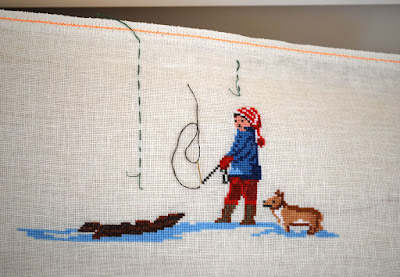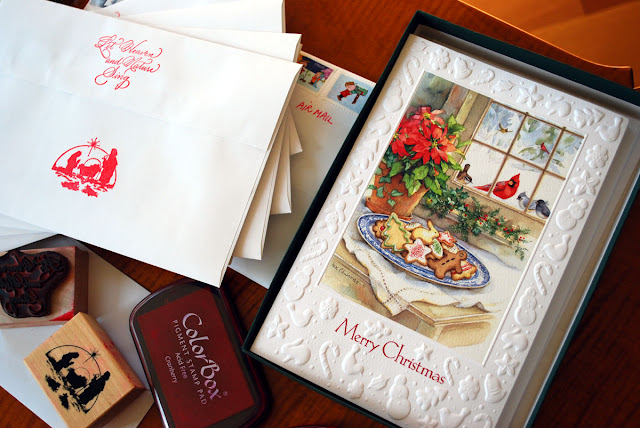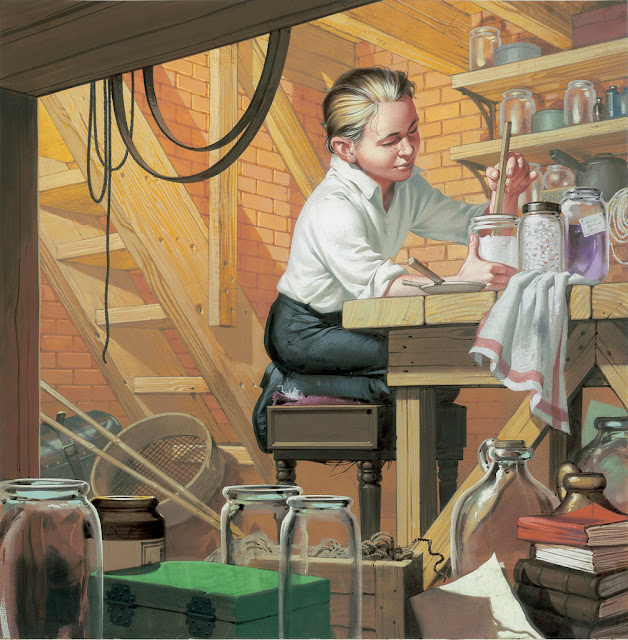Beauty in Necessity
The Lady-of-the-House has been picking up fabric fourths, hither and thither. Fabric shops dot Lancaster County run by Amish and Mennonite families. One of her favorite shops is in an old barn. When she decided to do some serious quilting - which for her meant doll quilts and pillows, she thought: "When in Rome do as the Romans do."
Reproduction fabrics interest the Lady-of-the-House. They can be pricey but 5 minutes from her house, fabric remnants - discontinued from previous year's prints - are sold in a variety store. She scouts around for "Marcus" prints now and again because the store re-stocks regularly and other scavengers are also on the look-out.
Recently, the Lady-of-the-House was in this variety store looking over the Christian Christmas cards, then made her familiar bee-line to the fabric isle. She carried two different prints to the cutting table, silently oo-ing and ahh-ing over her finds, "A quarter yard of each, please," she said - a phrase she had been known to say before.
With rotary cutter poised the fabric cutter smiled at her and said, "You're the Queen of Fourths."
"Well, this comes from following the scrappy look," replied the Lady-of-the-House apologetically. The fabric cutter meant no offense. She meant to be harmlessly amusing. But, perhaps she second-guessed her name-calling, for she softened the conversation by asking about the customer's Thanksgiving, who relaxed a bit and replied that she was happy to have her family together around her long table.
A Myriad of Tasks - A Blessing
A gift sent to the Lady-of-the-House this Christmastime was a deluxe seam ripper. This gift will be put to good use because she is a recurrent-seam-ripper. If she has been cross-stitching in the parlor or at the sewing machine, for half-an-hour, and runs into a snag, she will often call it quits and set the mistake aside. She can tackle ripping and re-stitching in a better frame of mind the following day when it is greeted as a first step.
 |
| I mark the middle of the figures as a counting reference. |
To do "the next thing" is something home teachers and homemakers are very familiar with as their tasks can be immensely varied - from correcting math pages to mopping floors. This myriad of tasks is actually a facet of homemaking to be thankful for. The Lady-of-the-House didn't recognize it as a blessing early on. Perhaps because her to-do list was once to blame for her occasionally feeling frazzled or run-off-her-feet. Applying Miss Mason principle of concise-precise sessions (and "sequence of lessons") however, enabled her to see her myriad of chores as indeed a blessing. Why?
 |
| Do you recognize this Tasha Tudor illustration? |
Short sessions of stitching is one restorative in the life of the Lady-of-the-House - a refreshing change of occupation.
 |
| Quilting a pillow cover. Gold fabric found in four different shops. |
The following statement pulled on her heartstrings when she heard it in a museum lecture.
A pioneer woman, living in a sod house, was asked why she quilts - when her day demands she tackle so many other chores before sunset - she replied:
"I make my quilts as fast as I can to keep my children from freezing and as beautiful as I can to keep my heart from breaking.
How do you turn a one-room sod house into a home, even if it's a temporary home on the American prairie? You make beautiful scrappy quilts. Homemakers long to create beauty within necessity. If at least one of their chores enables them to create something beautiful for their home (be it a garden, a meal, or an attractive piece of clothing) they can persevere.
Kathleen Tracy's Prairie Children and Their Quilts is one of the Lady-of-the-House's new favorite quilt books. When her girls were young, she would have gravitated to it - if the book had been written then and she had spied it at a book fair. She likes history and traditional crafts. It was, in the American girlhood of yesteryear, that small quilts like the doll quilts in this book, were made.
Mrs. Tracy carefully wraps 19th century first-hand sources around her quilt instructions. The old photographs, the letters and diaries in this book, written by prairie girls in the 19th century, are telling. They reveal some of the hardships of going west in a wagon train. They took me back to the days of Laura Ingalls Wilder - although Laura is understandably discreet - as the Little House Series is read aloud to so young an audience.
Prairie Children and Their Quilts is a history resource as much as a quilt book. After reading it as well as American Doll Quilts, and doing some of the projects, it occurred to the Lady-of-the-House that they would make enjoyable mother-daughter projects (for middle-school-though high school). But mostly Kathleen Tracy's books are purchased by grown-ups like the Lady-of-the-House who like the antique-look, who hadn't had any quilting in their girlhood, and who wish to backtrack some - just for fun.
A Little Quilt for Christmastime
When an antique doll quilt caught her eye, the Lady-of-the-House went bananas (but inwardly bananas so her menfolk wouldn't think her daft.) The red-n-white double nine-patch on-line looked to be so simple and sweet it called out to be replicated, leaving the solid squares empty of a quilt design as the original is, to retain its soft, oft-used, appearance. Pieced and hand-quilted in just two weeks, it is being used as a cheerful Christmas decoration. One day this cute doll-quilt will be handed down to her granddaughter.
 |
| A doll quilt made festive for Christmastime. |
In Closing
When the Lady-of-the-House returned from the variety store she had to smile. The phrase, "Queen of Fourths", she decided, was a compliment. It reminded her of what is recorded on her Mother Culture CD - that a homemaker is queen of her household. For love and duty, in all the myriad of tasks she fulfills, she is queen of a great many things.
 |
| Quilted with off-white thread. |
News
My article is up on Israel Wayne's Homeschool Pioneer website. Here you can read a host of stories.
Tasha Tudor Cross-stitch
Did you know that some of Tasha Tudor's illustrations have been made into cross-stitch? I bought one this year - well ahead of Christmas - made as a gift for a mother who has boys and corgis. She's unwrapped it and it's hanging on her wall this Christmastime. (The kit includes 18-ct Aida. I stitched on 28-ct linen bought separately.) Amazon has a few other Tasha Tudor designs.
 |
| Quaker Hand-of-Friendship, mostly known as Bear Paw. |
Tasha Tudor Cross-stitch Homeward Bound.
Prairie Children and Their Quilts.
 |
| Quilted with black thread with stitches of comfortable length. |
 |
| Frosty mornings but no snow yet. |
A Very Merry Christmas to you,
Karen Andreola















